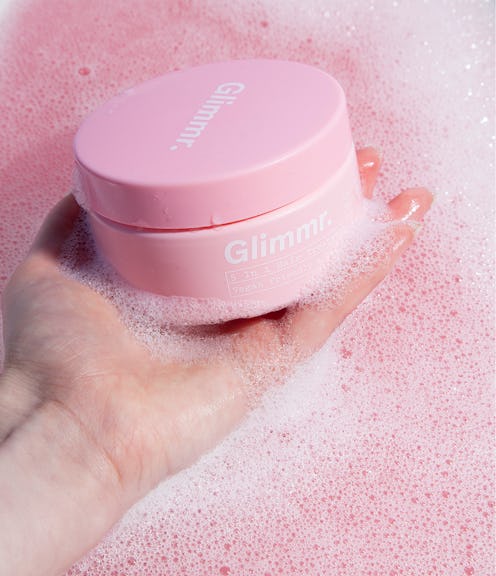(Review)
This Buzzy New Hair Mask Repairs Years Of Damage In Mere Minutes
We only recommend products we love and that we think you will, too. We may receive a portion of sales from products purchased from this article, which was written by our Commerce team.

As much as I love a multi-step skin care routine, there's something so much more satisfying about the immediate results of a good hair treatment. Where you'll need weeks of dedicated use to just maybe see a dramatic difference in your skin, a hair mask can noticeably transform dry, tangled ends into smooth, glossy strands in mere minutes. Glimmr's Coco Lush Hair Masque does just that with its blend of nourishing ingredients that improve the hair's health both immediately and over time, especially if you use it consistently. For the lowdown on this quick-fix solution for dry, damaged hair, read on.
Meet The Glimmr Coco Lush Hair Masque
Glimmr's 10-minute hair mask was designed in partnership with an Australian hair expert to combine more natural ingredients (aka ingredients with pronounceable names) into a vegan and cruelty-free formula that's still effective at repairing hair damage. Housed in the millennial pink tub is a mixture of fig extract, wheat protein extract, argan oil, castor oil, coconut butter, and other ingredients naturally rich in vitamins, minerals, and fatty acids that fuel healthy hair.
Called a “five-in-one” treatment, the tropical-scented mask leaves hair feeling softer and looking shinier after the very first use. With four weeks of regular use, you can also expect the strength of your hair to be improved, with less breakage and fewer split ends. And eight weeks out, the mask will have worked to its fullest potential: You can expect thicker, stronger hair with a glossier look and silkier feel.
What Hair Types Would Benefit From This Maks?
Because of the ingredients that Glimmr uses, all hair types (including fine, curly, and color-treated) can benefit from incorporating it into their hair care routine. The mask is so gentle that it can even be used by those with hair extensions to help keep them tangle-free. While those with curly and bleached hair will certainly benefit from the damage-repairing mask, I can personally attest that it won't weigh down fine hair or leave it looking greasy, something that’s often hard to find in conditioners and other hair treatments (Glimmr attributes this to the fig extract, which purportedly helps balance the hair's production of natural oils).
How To Use The Mask:
The Glimmr Coco Lush Hair Masque works like any other hair mask you may have used in the past. After you shampoo your hair, skip the conditioner, and instead, scoop out a tiny amount of the whipped mask and apply it from the mid-lengths to the ends of your hair (if your hair is thicker, you can massage it into your scalp, too). Let it sit for 10 minutes, then thoroughly rinse the mask out of your hair, and you're all set.
The brand advises that you use the mask just once a week — and keep it up for eight weeks to notice the full benefits. Following Glimmr's instructions, you can expect each tub to last you two to three months, but the brand also offers 20% to 35% discounts when you buy the mask in packs of two or three.
My Thoughts On The Mask
While I haven't used the mask long enough to speak to its long-term benefits, I definitely noticed an immediate difference in how my hair felt and looked. Firstly, the mask smells like coconut, and it has a lightweight texture that melts right into the hair when you apply it. I typically use a detangling spray post-shower because my hair is long and tends to get knotted, but after using the Glimmr mask, I skipped it entirely and had no trouble combing through my hair. I let my hair air dry (mostly because I'm lazy), and the end result was shiny, frizz-free hair that was significantly easier to run a brush through in the morning.
Glimmr promises to refund you your money if you aren’t satisfied with the immediate results — they’ll even send you a prepaid shipping label for a fuss-free way to return the mask — so what’s the harm in giving it a try?
This article was originally published on